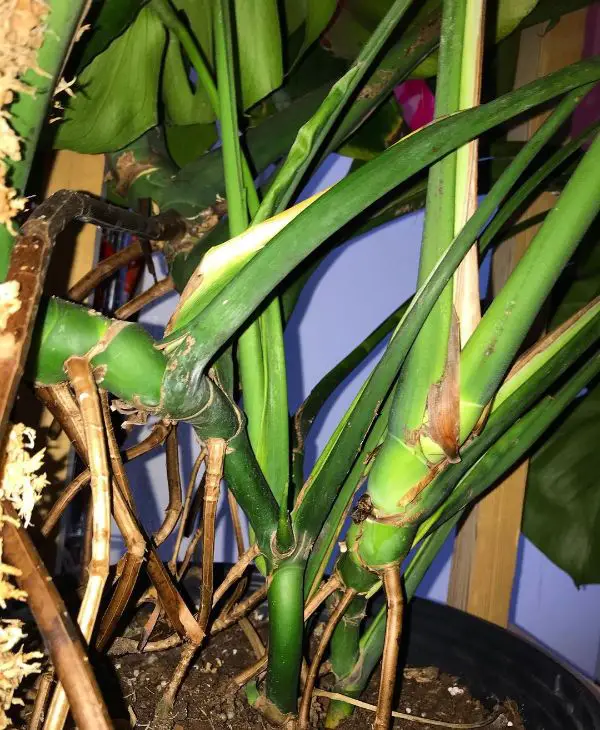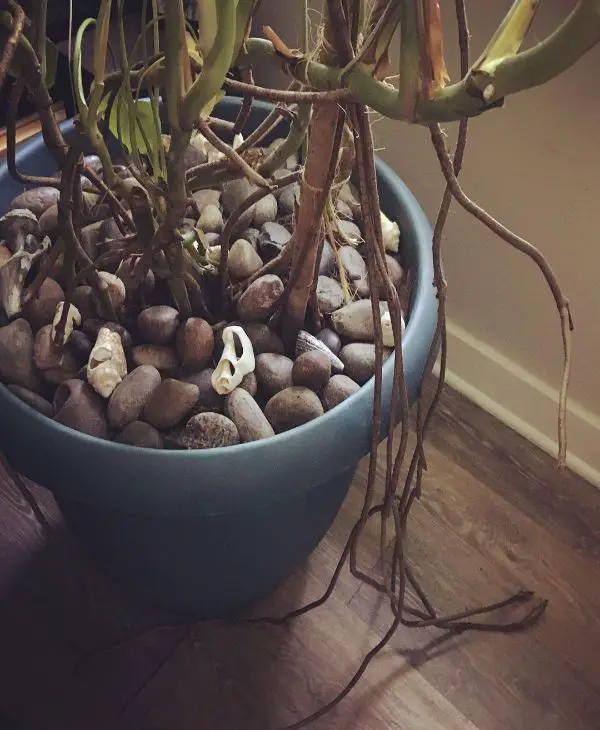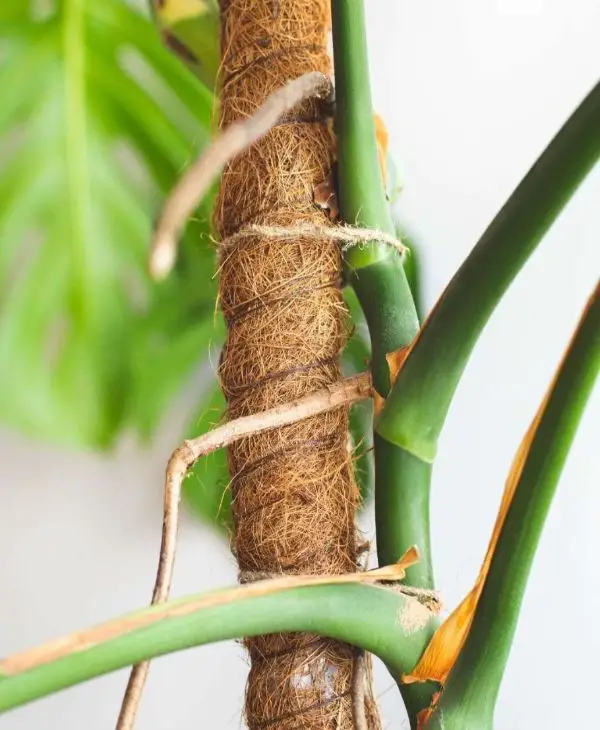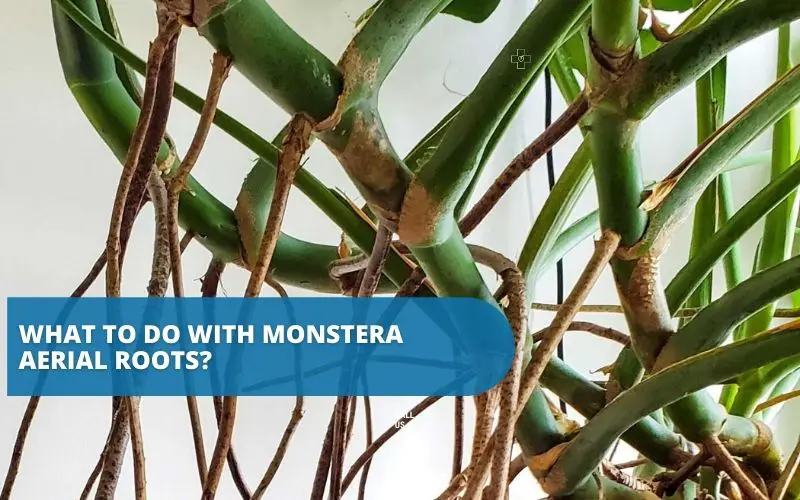Monstera aerial roots make many of you quite curious about why they can grow like that. Does this root growth affect the plant’s health, and how should we care for the Monstera that grows aerial roots?
Why are there Monstera aerial roots?
Climbing Monstera plants are epiphytes, which means they grow on other plants and climb up following the light. Monstera grows aerial roots to help them cling to surfaces they can climb, for example, Monstera Deliciosa aerial roots. Monstera wouldn’t get enough sunlight under the dense rainforest canopy without these aerial roots.

As a secondary function, aerial roots can draw water from attached root surfaces and even their air. Give the plants a little extra moisture to replenish what they’re getting from their roots in the ground. Great, isn’t it?
What do Aerial Roots look like?
It’s not difficult to spot an aerial root on your Monstera deliciosa houseplant. It may begin green, but unlike typical roots, it may ultimately develop a brown, woody cover.
Monstera aerial roots may get extremely thick in the wild, but they prefer to stay thin in the house. As your plant seeks to support, it can grow rather long and protrude in all directions.
If your Monstera deliciosa is developing a lot of aerial roots, tying it to a moss pole can be a nice option (also called a plant totem). This will provide a surface for the roots to connect to. After all, these are climbing plants, and they’ll thrive in this environment. It also minimizes the likelihood of branches breaking later on!
The growth of the aerial Monstera roots
On a large, fully-grown Monstera tree, you will notice aerial roots sprouting from the nodes of your tree. Younger roots may look smaller that develop into small green “branches .”Older aerial roots can brown and even become as sturdy as the primary roots, growing quite long!
A large, healthy Monstera plant can develop numerous aerial roots over time. And it can make them look messy and difficult to grow. These roots can also try to climb up your walls or furniture. It can stain the fence or break the finish.
The role of aerial roots
Like the role of everyday roots, Monstera aerial roots have some essential functions, including absorption of nutrients, storing nutrients, reproduction, and photosynthesis. Of course, we can still say that those kinds of their role are not as important as the primary roots.
- Absorption of nutrients: Just like roots that grow at the base of a tree, aerial roots help plants absorb nutrients from the environment they come to climb.
- Store nutrients: Because the long, climbing trunk will need to provide more nutrients, the aerial roots help the plant store nutrients and provide nutrients to the trunk.
- Reproduction and photosynthesis: In addition, it has a function to help plants reproduce and photosynthesize.
Monstera aerial roots can rot. Due to a decrease of oxygen in the water. It leads to the roots being submerged in water and unable to breathe. For example, when growing plants with static hydroponics, the nutrient medium will be stationary, with no metabolism. Since then, the roots do not have respiration causing root rot. Besides, when the temperature increases, it also affects. Plants can be infected with bacteria or microorganisms.

Take care of Monstera to develop more aerial roots
After Monstera has aerial roots, you should regularly mist, prune and use a moss pole for its aerial roots to develop well. What to do with Monstera aerial roots is what you should know below.
Regularly mist and water Monstera
First, you install misting nozzles in the area where Monstera grows. These misting nozzles will create the necessary humidity for the entire Monstera growing area. The frequency of misting during the day is as follows:
Monstera develops perfect aerial roots when provided with adequate air humidity. It seems that these roots are all greenish-white roots. The roots are not dry and black. In addition, misting like this will provide moisture to the surface of Monstera leaves. Then these leaves will look greener in a hot, dry area.
The second thing is after Monstera has developed the aerial roots. This root will absorb water and get the moisture it needs to grow longer. In addition, you can use coir pieces or Sphagnum moss to wrap around the pillar to help roots stick.
Monstera roots dry after watering and retain moisture for about 1-2 hours. On average, you will also water it about three times a day. Here are some of the aẻial roots that have started developing and growing. Creating the necessary conditions for the aerial roots of Monstera to live and design has helped these leaves grow greener, and the last leaves are usually more significant than the original ones.
Related Post: How to grow Monstera from seed? [Easy – Fastest way]
Regularly prune Monstera’s aerial roots
If your aerial roots look a bit unsightly, you can prune them. It will help if you use sharp scissors (sterilize before use). Cut close to the roots where they grow from the tree. If you want to minimize root regrowth, pruning will stimulate more aerial roots to produce, so try pruning them in late summer or early fall after the growing season.
Pruning the aerial roots can slow down the overall growth of the plant. So it is the best option if your goal is to grow a giant monster with thick leaves. If you’re struggling with a giant monster, you’re better off leaving the roots alone and letting them do what they want to do: climb!
Planting it with a moss pole
Your other option for aerial root management is to give your Monstera something to climb on. Your best bet is a truss or a moss/hardwood pole. You can buy these or easily make your own at home! If you want to know how to make a moss pole for Monstera, please follow us on the link below. There are some simple ways to make it at home to save money. A moss pole is more important for some types of Monstera like Monstera Deliciosa.
Learn more about how to use a moss pole for Monstera at: https://dignursery.com/how-to-attach-monstera-to-a-moss-pole/
Once you have the stand, carefully insert it into the soil or near the plant’s pot and tie the thickest stems to the support to encourage the aerial roots to attach themselves to it. Try choosing a pole a little tall enough for the roots room to grow before you have to prune or get a more elevated stand.

Is it ok to put Monstera Aerial roots in water?
The majority of the time, you should avoid putting Monstera aerial roots in water. While they can absorb moisture, they aren’t usually designed to remain submerged all of the time.
This can also injure underground roots indirectly by causing overwatering. A Monstera begins to rely on aerial roots as its primary supply of hydration when they have such easy access to continual water. Subterranean roots will grow less and will not descend deep enough into the soil as a result of this.
When this happens, the underground roots are unable to receive moisture from the soil as indicated by the manufacturer. If the soil remains damp for an extended period of time, the ground roots will decay!
Should I cut off Monstera Aerial Roots?
It’s best not to chop off the aerial roots of monstera plants. One rationale for preserving aerial roots on your monstera plant is that without them, the monstera plant’s leaves will not develop beyond a particular size. The monstera plant, in other words, will not produce mature leaves.
Another concern is that chopping off aerial roots, especially with filthy equipment, exposes the plant to bacterial, fungal, and other illnesses.
You can trim off some of the aerial roots that are an eyesore or producing problems in your house if your monstera plant has too many aerial roots. However, there is one key caveat: cut off roots with sterilized instruments and make sure you don’t harm the plant’s stem in the process.
You don’t want to spread germs, viruses, or fungus to the plant, and an unsterilized blade can do just that.
Alternatively, if aerial roots aren’t bothering you and aren’t bothering you in any other way, you can leave them alone or tuck them into the pot.
Should I plant the aerial roots of my Monstera in the soil?
We’ve read that aerial roots may be trained to grow in soil. It’s not a good idea to train them to grow into the soil since their limited ability to absorb moisture makes them prone to rotting.
I’m not sure you can just ‘convince’ an aerial root to turn into a subterranean one. It’s not going to work in the long run.
Because these roots have varied functions and don’t all act in the same way, burying an aerial root in the soil might cause it to decay, which is something you definitely don’t want to happen.
Double-potting your monstera, on the other hand, is an option. Simply place your potted monstera in a larger pot, allowing the roots to be snuggled into the larger pot without rotting due to excessive wetness.
You may also just leave aerial roots alone. Attaching them to a moss pole or similar structures can help to prevent them from falling into walls or bookcases.


